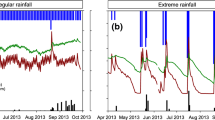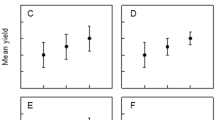Abstract
Positive diversity–productivity relationships have repeatedly been found in experimental grassland plots, but mechanistic explanations are still under debate. We tested whether complementarity for the exploitation of the soil water resource helps to explain these relationships. In the dry summer of 2003, evapotranspiration (ET) was assessed at the Swedish BIODEPTH site using two different approaches: snapshot measurements of canopy surface temperature and simulation of time-accumulated ET by means of a soil water balance model. More diverse plots were characterized by lower surface temperatures and higher accumulated ET. Transgressive overyielding tests revealed that ET in polycultures was higher than in the best-performing monocultures, but this pattern was reversed at high degrees of water stress. Our results indicate that a more complete exploitation of soil water by more diverse grassland systems is on the one hand likely to be a driver for their increased biomass production, but on the other hand causes the more diverse communities to be affected earlier by drought. Nevertheless, the results also suggest that productivity may (at least partially) be maintained under dry conditions due to the higher likelihood of including drought-tolerant species in the more diverse communities.




Similar content being viewed by others
References
Allen R, Pereira L, Raes D, Smith M (1998) FAO Irrigation and Drainage paper number 56. Crop evapotranspiration. Guidelines for computing crop water requirements. FAO, Rome
Belmans C, Wesseling JG, Feddes RA (1983) Simulation of the water balance of a cropped soil: SWATRE. J Hydrol 63:271–286
Caldeira MC, Ryel RJ, Lawton JH, Pereira JS (2001) Mechanisms of positive biodiversity-production relationships: insights provided by delta C-13 analysis in experimental mediterranean grassland plots. Ecol Lett 4:439–443
de Wit CT (1958) Transpiration and crop yields. Agricultural research reports 64.6. Pudoc, Wageningen
De Boeck HJ, Lemmens CMHM, Bossuyt H, Malchair S, Carnol M, Merckx R, Nijs I, Ceulemans R (2006) How do climate warming and plant species richness affect water use in experimental grasslands? Plant Soil 288:246–261
Ellenberg H, Weber HE, Düll R, Wirth V, Werner W, Paulissen D (1991) Zeigerwerte von Pflanzen in Mitteleuropa. Goltze, Göttingen
Feddes RA, Kowalik PJ, Zaradny H (1978) Simulation of field water use and crop yield. simulation monographs. Pudoc, Wageningen
Grime JP, Hodgson JG, Hunt R (1988) Comparative plant ecology: a functional approach to common British species. Unwin Hyman, London
Hatfield JL, Perrier A, Jackson RD (1983) Estimation of evapotranspiration at one time-of-day using remotely sensed surface temperatures. Agric Water Manage 7:341–350
Hector A (2001) Biodiversity and the functioning of grassland ecosystems: multi-site comparisons. In: Kinzig AP, Pacala SW, Tilman D (eds) The functional consequences of biodiversity: empirical progress and theoretical extensions. Princeton University Press, Princeton, pp 71–95
Hector A, Schmid B, Beierkuhnlein C, Caldeira MC, Diemer M., Dimitrakopoulos PG, Finn JA, Freitas H, Giller PS, Good J, Harris R, Hogberg P, Huss-Danell K, Joshi J., Jumpponen A, Korner C, Leadley PW, Loreau M, Minns A, Mulder CPH, O’donovan G, Otway SJ, Pereira JS, Prinz A, Read DJ, Scherer-Lorenzen M, Schulze ED, Siamantziouras ASD, Spehn EM, Terry AC, Troumbis AY, Woodward FI, Yachi S, Lawton H (1999) Plant diversity and productivity experiments in European grasslands. Science 286:1123–1127
Hector A, Bazeley-White E, Loreau M, Otway S, Schmid B (2002) Overyielding in grassland communities: testing the sampling effect hypothesis with replicated biodiversity experiments. Ecol Lett 5:502–511
Hoogland JC, Belmans C, Feddes RA (1981) Root water uptake model depending on soil water pressure heads and maximum water extraction rate. Acta Hortic 119:123–135
Hooper DU, Dukes JS (2004) Overyielding among plant functional groups in a long-term experiment. Ecol Lett 7:95–105
Hooper DU, Vitousek PM (1997) The effects of plant composition and diversity on ecosystem processes. Science 277:1302–1305
Hooper DU, Chapin III FS, Ewel JJ, Hector A, Inchausti P, Lavorel S, Lawton H, Lodge DM, Loreau M, Naeem S, Schmid B, Setälä H, Symstad AJ, Vandermeer J, Wardle DA (2005) Effects of biodiversity on ecosystem functioning: a consensus of current knowledge. Ecol Monogr 75:3–35
Huston MA (1997) Hidden treatments in ecological experiments: re-evaluating the ecosystem function of biodiversity. Oecologia 110:449–460
Jarvis AJ, Davies WJ (1998) The coupled response of stomatal conductance to photosynthesis and transpiration. J Exp Bot 49:399–406
Kahmen A, Perner J, Buchmann N (2005) Diversity-dependent productivity in semi-natural grasslands following climate perturbations. Funct Ecol 19:594–601
Kinzig AP, Pacala W, Tilman D (2001) The functional consequences of biodiversity: empirical progress and theoretical extensions. Princeton University Press, Princeton
Lambers JHR, Harpole WS, Tilman D, Knops J, Reich PB (2004) Mechanisms responsible for the positive diversity–productivity relationship in Minnesota grasslands. Ecol Lett 7:661–668
Lambinon J, De Langhe JE, Delvosalle L, Duvigneaud J (1998) Flora van België, het Groothertogdom Luxemburg, Noord-Frankrijk en de aangrenzende gebieden (pteridofyten en spermatofyten). Nationale Plantentuin van België, Meise
Leuzinger S, Körner C (2007) Tree species diversity affects canopy leaf temperatures in a mature temperate forest. Agric For Meteorol 146:29–37
Loreau M, Hector A (2001) Partitioning selection and complementarity in biodiversity experiments. Nature 412:72–76
Loreau M, Naeem S, Inchausti P, Bengtsson J, Grime JP, Hector A, Hooper DU, Huston MA, Raffaelli D, Schmid B, Tilman D, Wardle DA (2001) Ecology–biodiversity and ecosystem functioning: current knowledge and future challenges. Science 294:804–808
Loreau M, Naeem S, Inchausti P (2002) Biodiversity and ecosystem functioning: synthesis and perspectives. Oxford University Press, Oxford
Lu Z, Lemeur R (1995) Evaluation of daily evapotranspiration estimates from instantaneous measurements. Agric For Meteorol 74:139–154
Mulder CPH, Jumpponen A, Hogberg P, Huss-Danell K (2002) How plant diversity and legumes affect nitrogen dynamics in experimental grassland communities. Oecologia 133:412–421
Nippert JB, Knapp AK (2007) Soil water partitioning contributes to species coexistence in tallgrass prairie. Oikos 116:1017–1029
Palmborg C, Scherer-Lorentzen M, Jumpponen A, Carlsson G, Huss-Danell K, Högberg P (2005) Inorganic soil nitrogen under grassland plant communities of different species composition and diversity. Oikos 110:271–282
Peat H, Fitter A (1994) The ecological flora of the British Isles at the University of York. www document: http://www.york.ac.uk/res/ecoflora/cfm/ecofl/
Pfisterer AB, Schmid B (2002) Diversity-dependent production can decrease the stability of ecosystem functioning. Nature 416:84–86
Raes D (1982) A summary simulation model of the water budget of a cropped soil. Dissertationes de agricultura number 122. K.U. Leuven, Leuven
Raes D, Lemmens H, Van Aelst P, Vanden Bulcke M, Smith M (1988) IRSIS—irrigation scheduling information system, vol 1. Reference manual 3. K.U. Leuven, Leuven
Raes D, Geerts S, Kipkorir E, Wellens J, Sahli A (2006) Simulation of yield decline as a result of water stress with a robust soil water balance model. Agric Water Manage 81:335–357
Reich PB, Knops J, Tilman D, Craine J, Ellsworth D, Tjoelker M, Lee T, Wedin D, Naeem S, Bahauddin D, Hendrey G, Jose S, Wrage K, Goth J, Bengston W (2001) Plant diversity enhances ecosystem responses to elevated CO2 and nitrogen deposition. Nature 410:809–812
Reich PB, Tilman D, Naeem S, Ellsworth DS, Knops J, Craine J, Wedin D, Trost J (2004) Species and functional group diversity independently influence biomass accumulation and its response to CO2 and N. Proc Natl Acad Sci USA 101:10101–10106
Rixen C, Mulder CPH (2005) Improved water retention links high species richness with increased productivity in arctic tundra moss communities. Oecologia 146:287–299
Schmid B, Joshi J, Schläpfer F (2001) Empirical evidence for biodiversity-ecosystem functioning relationships. In: Kinzig AP, Pacala SW, Tilman D (eds) The functional consequences of biodiversity: empirical progress and theoretical extensions. Princeton University Press, Princeton, pp 120–150
Silvertown J (2004) Plant coexistence and the niche. Trends Ecol Evol 19:605–611
Silvertown J, Dodd ME, Gowing DJG, Mountford JO (1999) Hydrologically defined niches reveal a basis for species richness in plant communities. Nature 400:61–63
SMHI (2003) Väder och vatten. Swedish Metherological and Hydrological Institute, no. 8 August. Swedish Metherological and Hydrological Institute, Norrkö**
Spehn EM, Joshi J, Schmid B, Diemer M, Körner C (2000a) Above-ground resource use increases with plant species richness in experimental grassland ecosystems. Funct Ecol 14:326–337
Spehn EM, Joshi J, Schmid B, Alphei J, Körner C (2000b) Plant diversity effects on soil heterotrophic activity in experimental grassland ecosystems. Plant Soil 224:217–230
Spehn EM, Hector A, Joshi J, Scherer-Lorenzen M, Schmid B, Bazeley-White E, Beierkuhnlein C, Caldeira MC, Diemer M, Dimitrakopoulos PG, Finn JA, Freitas H, Giller PS, Good J, Harris R, Hogberg P, Huss-Danell K, Jumpponen A, Koricheva J, Leadley PW, Loreau M, Minns A, Mulder CPH, O’Donovan G, Otway SJ, Palmborg C, Pereira JS, Pfisterer AB, Prinz A, Read DJ, Schulze ED, Siamantziouras ASD, Terry AC, Troumbis AY, Woodward FI, Yachi S, Lawton JH (2005) Ecosystem effects of biodiversity manipulations in European grasslands. Ecol Monogr 75:37–63
Stocker R, Körner C, Schmid B, Niklaus PA, Leadley PW (1999) A field study of the effects of elevated Co2 and plant species diversity on ecosystem-level gas exchange in a planted calcareous grassland. Glob Chang Biol 5:95–105
Tilman D, Lehman CL, Thomson KT (1997) Plant diversity and ecosystem productivity: theoretical considerations. Proc Natl Acad Sci USA 94:1857–1861
Tilman D, Reich PB, Knops J, Wedin D, Mielke T, Lehman C (2001) Diversity and productivity in a long-term grassland experiment. Science 294:843–845
Tilman D, Reich PB, Knops J (2006) Biodiversity and ecosystem stability in a decade-long grassland experiment. Nature 441:629–632
Van Ruijven J, Berendse F (2003) Positive effects of plant species diversity on productivity in the absence of legumes. Ecol Lett 6:170–175
Van Ruijven J, Berendse F (2005) Diversity–productivity relationships: initial effects, long-term patterns, and underlying mechanisms. Proc Natl Acad Sci 102:695–700
Van der Krift TAJ, Kuikman PJ, Möller F, Berendse F (2001) Plant species and nutritional-mediated control over rhizodeposition and root decomposition. Plant Soil 228:191–200
Van Peer L, Nijs I, Reheul D, De Cauwer B (2004) Species richness and susceptibility to heat and drought extremes in synthesized grassland ecosystems: compositional vs physiological effects. Funct Ecol 18:769–778
Violle C, Lecoeur J, Navas ML (2007) How relevant are instantaneous measurements for assessing resource depletion under plant cover? A test on light and soil water availability in 18 herbaceous communities. Funct Ecol 21:185–190
Wagendorp T, Gulinck H, Coppin P, Muys B (2006) Land use impact evaluation in life cycle assessment based on ecosystem thermodynamics. Energy 31:112–125
Wang Y, Yu S, Wang J (2007) Biomass-dependent susceptibility to drought in experimental grassland communities. Ecol Lett 10:401–410
Yachi S, Loreau M (2007) Does complementary resource use enhance ecosystem functioning? A model of light competition in plant communities. Ecol Lett 10:54–62
Acknowledgements
We thank the SLU Department of Agricultural Research in northern Sweden for providing the carefully maintained research site. This work was supported by the Ministry of the Flemish Community, Forest and Green Areas Division, TWOL project B&G/27/2002. Jeroen Staelens helped make the figures and Mark Vellend kindly commented on an earlier version of this manuscript.
Author information
Authors and Affiliations
Corresponding author
Additional information
Communicated by Nina Buchmann.
Electronic supplementary material
Below is the link to the electronic supplementary material.
Rights and permissions
About this article
Cite this article
Verheyen, K., Bulteel, H., Palmborg, C. et al. Can complementarity in water use help to explain diversity–productivity relationships in experimental grassland plots?. Oecologia 156, 351–361 (2008). https://doi.org/10.1007/s00442-008-0998-x
Received:
Accepted:
Published:
Issue Date:
DOI: https://doi.org/10.1007/s00442-008-0998-x




